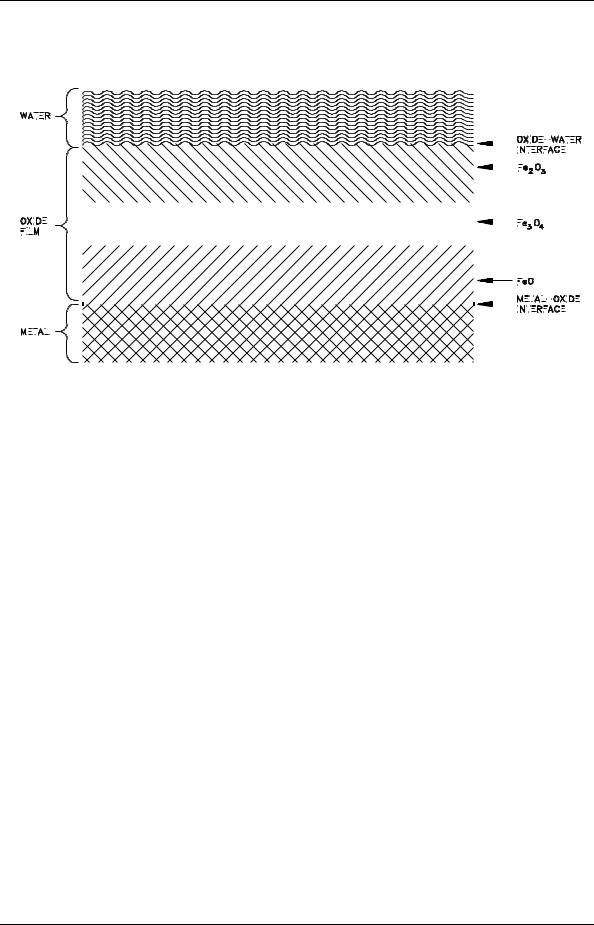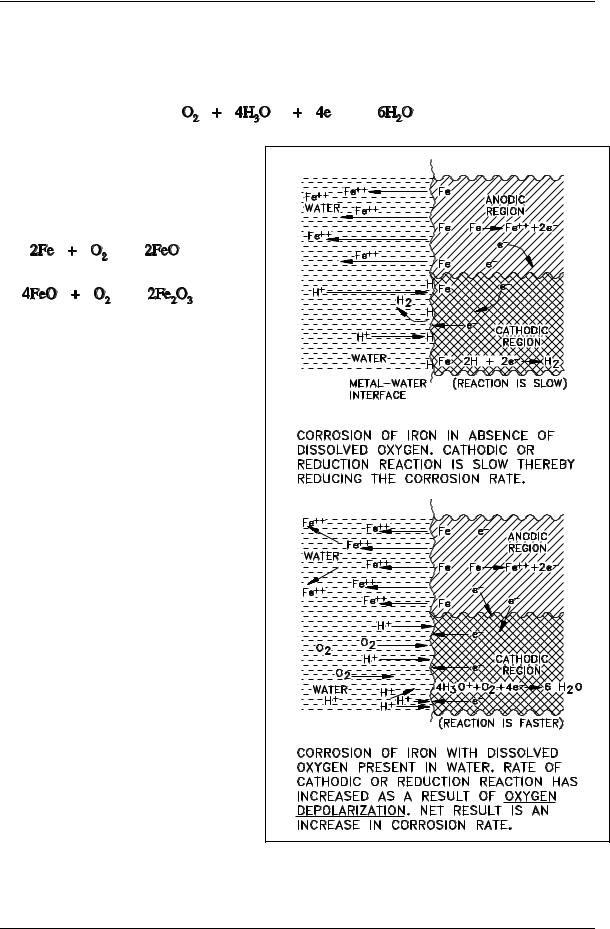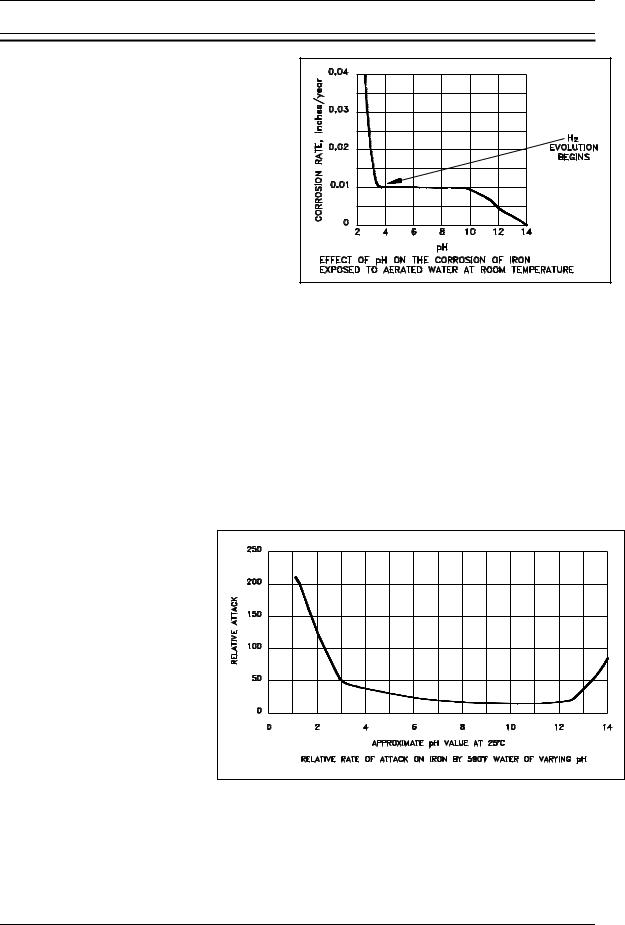
- •ABSTRACT
- •FOREWORD
- •OVERVIEW
- •TABLE OF CONTENTS
- •LIST OF FIGURES
- •LIST OF TABLES
- •REFERENCES
- •OBJECTIVES
- •CHARACTERISTICS OF ATOMS
- •Characteristics of Matter
- •The Atom Structure
- •Chemical Elements
- •Molecules
- •Avogadro's Number
- •The Mole
- •Mole of Molecules
- •Summary
- •THE PERIODIC TABLE
- •Periodic Table
- •Classes of the Periodic Table
- •Group Characteristics
- •Atomic Structure of Electrons
- •Summary
- •CHEMICAL BONDING
- •Chemical Bonding
- •Ionic Bonds
- •Covalent Bonds
- •Metallic Bonds
- •Van der Waals Forces
- •Organic Chemistry
- •Alkanes
- •Alkenes
- •Alkynes
- •Aromatics
- •Alcohols
- •Aldehydes
- •Basic Chemical Laws
- •Forming Chemical Compounds
- •Combining Elements
- •Summary
- •CHEMICAL EQUATIONS
- •Le Chatelier's Principle
- •Density
- •Molarity
- •Normality
- •Parts per Million
- •Chemical Equations
- •Balancing Chemical Equations
- •Summary
- •ACIDS, BASES, SALTS, AND pH
- •Acids
- •Bases
- •Salts
- •Dissociation Constant
- •Summary
- •Introduction
- •Isotopic Separation
- •Separation Factor
- •Stage Separation
- •Barrier Measurements
- •Cascade Theory
- •Circuit Balances
- •CONVERTERS
- •Converters
- •Converter Construction
- •The Gas Cooler
- •Barrier Tubing
- •Process Gas Flow
- •Diffusion
- •TABLE OF CONTENTS
- •LIST OF FIGURES
- •LIST OF TABLES
- •REFERENCES
- •OBJECTIVES
- •CORROSION THEORY
- •Corrosion
- •Electrochemical Cells
- •Oxidation-Reduction Reactions
- •Passivity and Polarization of Metal
- •Summary
- •GENERAL CORROSION
- •Conditions Contributing to General Corrosion
- •Corrosion of Iron
- •Factors Affecting General Corrosion Rate
- •Prevention Chemistry Control
- •Corrosion of Aluminum
- •Summary
- •CRUD AND GALVANIC CORROSION
- •Crud
- •Galvanic Corrosion
- •Prevention of Galvanic Corrosion
- •Summary
- •SPECIALIZED CORROSION
- •Pitting and Crevice Corrosion
- •Stress Corrosion Cracking
- •Summary

Corrosion |
DOE-HDBK-1015/1-93 |
GENERAL CORROSION |
|
|
|
GENERAL CORROSION
This chapter describes the general corrosion processes of iron and carbon steel (not stainless steels) in aqueous environments. Of particular interest is the formation of the oxide film and the effects of system variables on the corrosion process.
EO 1.7 LIST the two conditions that contribute to general corrosion.
EO 1.8 DESCRIBE how the rate of corrosion occurring in the plant is effected by the following:
a.Temperature
b.Water velocity
c.Oxygen
d.pH
e.Condition and composition of the metal surface
f.Dissolved solids
EO 1.9 LIST the three products that are formed from the general corrosion of iron.
EO 1.10 IDENTIFY the action taken for initial fill of a reactor system to limit general corrosion.
EO 1.11 STATE the four methods used to chemically control general plant corrosion.
EO 1.12 LIST the six water chemistry conditions that limit corrosion of aluminum.
Conditions Contributing to General Corrosion
General corrosion is the process whereby the surface of a metal undergoes a slow, relatively uniform, removal of material. The two conditions typically required for a metal to undergo general corrosion are: 1) metal and water in the same environment, and 2) a chemical reaction between the metal and water that forms an oxide.
Rev. 0 |
Page 11 |
CH-02 |

GENERAL CORROSION |
DOE-HDBK-1015/1-93 |
Corrosion |
|
|
|
Corrosion of Iron
Unless noted otherwise, the following discussion applies to deaerated water at room temperature and approximately neutral pH. The affects of temperature, oxygen, and pH are discussed later in this chapter.
The oxidation and reduction half-reactions in the corrosion of iron are as follows.
|
|
|
(2-3) |
|
|
|
(2-4) |
The overall reaction is the sum of these half-reactions.
|
|
(2-8) |
The Fe+2 ions readily combine with OH- ions at the metal surface, first forming Fe(OH)2, which decomposes to FeO.
|
|
|
(2-9) |
Ferrous oxide (FeO) then forms a layer on the surface of the metal. Below about 1000(F, however, FeO is unstable and undergoes further oxidation.
|
(2-10) |
Atomic hydrogen then reacts to form molecular hydrogen, as described previously, and a layer of ferric oxide (Fe2O3) builds up on the FeO layer. Between these two layers is another layer that has the apparent composition Fe3O4. It is believed that Fe3O4 is a distinct crystalline state composed of O-2, Fe+2, and Fe+3 in proportions so that the apparent composition is Fe3O4. These three layers are illustrated in Figure 5.
Once the oxide film begins to form, the metal surface is no longer in direct contact with the aqueous environment. For further corrosion to occur, the reactants must diffuse through the oxide barrier. It is believed that the oxidation step, Equation (2-3), occurs at the metal-oxide interface. The Fe+2 ions and electrons then diffuse through the oxide layer toward the oxide-water interface. Eventually, Fe+2 ions encounter OH- ions and form FeO. The electrons participate in the reduction reaction with hydronium ions. These latter reactions are believed to take place predominately at the oxide-water interface, but some reaction may occur within the oxide layer by the diffusion of H+, OH-, and H2O into the layer.
CH-02 |
Page 12 |
Rev. 0 |

Corrosion |
|
|
|
|
|
|
|
|
|
|
|
|
|
|
|
|
DOE-HDBK-1015/1-93 |
GENERAL CORROSION |
|
||||||||||||||||||||||||||||||||||||||||||||||||||||
|
|
|
|
|
|
|
|
|
|
|
|
|
|
|
|
|
|
|
|
|
|
|
|
|
|
|
|
|
|
|
|
|
|
|
|
|
|
|
|
|
|
|
|
|
|
|
|
|
|
|
|
|
|
|
|
|
|
|
|
|
|
|
|
|
|
|
|
|
|
|
|
|
|
|
|
|
|
|
|
|
|
|
|
|
|
|
|
|
|
|
|
|
|
|
|
|
|
|
|
|
|
|
|
|
|
|
|
|
|
|
|
|
|
|
|
|
|
|
|
|
|
|
|
|
|
|
|
|
|
|
|
|
|
|
|
|
|
|
|
|
|
|
|
|
|
|
|
|
|
|
|
|
|
|
|
|
|
|
|
|
|
|
|
|
|
|
|
|
|
|
|
|
|
|
|
|
|
|
|
|
|
|
|
|
|
|
|
|
|
|
|
|
|
|
|
|
|
|
|
|
|
|
|
|
|
|
|
|
|
|
|
|
|
|
|
|
|
|
|
|
|
|
|
|
|
|
|
|
|
|
|
|
|
|
|
|
|
|
|
|
|
|
|
|
|
|
|
|
|
|
|
|
|
|
|
|
|
|
|
|
|
|
|
|
|
|
|
|
|
|
|
|
|
|
|
|
|
|
|
|
|
|
|
|
|
|
|
|
|
|
|
|
|
|
|
|
|
|
|
|
|
|
|
|
|
|
|
|
|
|
|
|
|
|
|
|
|
|
|
|
|
|
|
|
|
|
|
|
|
|
|
|
|
|
|
|
|
|
|
|
|
|
|
|
|
|
|
|
|
|
|
|
|
|
|
|
|
|
|
|
|
|
|
|
|
|
|
|
|
|
|
|
|
|
|
|
|
|
|
|
|
|
|
|
|
|
|
|
|
|
|
|
|
|
|
|
|
|
|
|
|
|
|
|
|
|
|
|
|
|
|
|
|
|
|
|
|
|
|
|
|
|
|
|
|
|
|
|
|
|
|
|
|
|
|
|
|
|
|
|
|
|
|
|
|
|
|
|
|
|
|
|
|
|
|
|
|
|
|
|
|
|
|
|
|
|
|
|
|
|
|
|
|
|
|
|
|
|
|
|
|
|
|
|
|
|
|
|
|
|
|
|
|
|
|
|
|
|
|
|
|
|
|
|
|
|
|
|
|
|
|
|
|
|
|
|
|
|
|
|
|
|
|
|
|
|
|
|
|
|
|
|
|
|
|
|
|
|
|
|
|
|
|
|
|
|
|
|
|
|
|
|
|
|
|
|
|
|
|
|
|
|
|
|
|
|
|
|
|
|
|
|
|
|
|
|
|
|
|
|
|
|
|
|
|
|
|
|
|
|
|
|
|
|
|
|
|
|
|
|
|
|
|
|
|
|
|
|
|
|
|
|
|
|
|
|
|
|
|
|
|
|
|
|
|
|
|
|
|
|
|
|
|
|
|
|
|
|
|
|
|
|
|
|
|
|
|
|
|
|
|
|
|
|
|
|
|
|
|
|
|
|
|
|
|
|
|
|
|
|
|
|
|
|
|
|
|
|
|
|
|
|
|
|
|
|
|
|
|
|
|
|
|
|
|
|
|
|
|
|
|
|
|
|
|
|
|
|
|
|
|
|
|
|
|
|
|
|
|
|
|
|
|
|
|
|
|
|
|
|
|
|
|
|
|
|
|
|
|
|
|
|
|
|
|
|
|
|
|
|
|
|
|
|
|
|
|
|
|
|
|
|
|
|
|
|
|
|
|
|
|
|
|
|
|
|
|
|
|
|
|
|
|
|
|
|
|
|
|
|
|
|
|
|
|
|
|
|
|
|
|
|
|
|
|
|
|
|
|
|
|
|
|
|
|
|
|
|
|
|
|
|
|
|
|
|
|
|
|
|
|
|
|
|
|
|
|
|
|
|
|
|
|
|
|
|
|
|
|
|
|
|
|
|
|
|
|
|
|
|
|
|
|
|
|
|
|
|
|
|
|
|
|
|
|
|
|
|
|
|
|
|
|
|
|
|
|
|
|
|
|
|
|
|
|
|
|
|
|
|
|
|
|
|
|
|
|
|
|
|
|
|
|
|
|
|
|
|
|
|
|
|
|
|
|
|
|
|
|
|
|
|
|
|
|
|
|
|
|
|
|
|
|
|
|
|
|
|
|
|
|
|
|
|
|
|
|
|
|
|
|
|
|
|
|
|
|
|
|
|
|
|
|
|
|
|
|
|
|
|
|
|
|
|
|
|
|
|
|
|
|
|
|
|
|
|
|
|
|
|
|
|
|
|
|
|
|
|
|
|
|
|
|
|
|
|
|
|
|
|
|
|
|
|
|
|
|
|
|
|
|
|
|
|
|
|
|
|
|
|
|
|
|
|
|
|
|
|
|
|
|
|
|
|
|
|
|
|
|
|
|
|
|
|
|
|
|
|
|
|
|
|
|
|
|
|
|
|
|
|
|
|
|
|
|
|
|
|
|
|
|
|
|
|
|
|
|
|
|
|
|
|
|
|
|
|
|
|
|
|
|
|
|
|
|
|
|
|
|
|
|
|
|
|
|
|
|
|
|
|
|
|
|
|
|
|
|
|
|
|
|
|
|
|
|
|
|
|
|
|
|
|
|
|
|
|
|
|
|
|
|
|
|
|
|
|
|
|
|
|
|
|
|
|
|
|
|
|
|
|
|
|
|
|
|
|
|
|
|
|
|
|
|
|
|
|
|
|
|
|
|
|
|
|
|
|
|
|
|
|
|
|
|
|
|
|
|
|
|
|
|
|
|
|
|
|
|
|
|
|
|
|
|
|
|
|
|
|
|
|
|
|
|
|
|
|
|
|
|
|
|
|
|
|
|
|
|
|
|
|
|
|
|
|
|
|
|
|
|
|
|
|
|
|
|
|
|
|
|
|
|
|
|
|
|
|
|
|
|
|
|
|
|
|
|
|
|
|
|
|
|
|
|
|
|
|
|
|
|
|
|
|
|
|
|
|
|
|
|
|
|
|
|
|
|
|
|
|
|
|
|
|
|
|
|
|
|
|
|
|
|
|
|
|
|
|
|
|
|
|
|
|
|
|
|
|
|
|
|
|
|
|
|
|
|
|
|
|
|
|
|
|
|
|
|
|
|
|
|
|
|
|
|
|
|
|
|
|
|
|
|
|
|
|
|
|
|
|
|
|
|
|
|
|
|
|
|
|
|
|
|
|
|
|
|
|
|
|
|
|
|
|
|
|
|
|
|
|
|
|
|
|
|
|
|
|
|
|
|
Figure 5 Simplified Schematic Diagram of Oxide Corrosion Film on the Surface of a Metal
Regardless of the exact diffusion mechanism, the oxide layer represents a barrier to continued corrosion and tends to slow the corrosion rate. The exact effect of this layer on the corrosion rate depends on the uniformity and tenacity of the film. If the film is loosely attached, develops defects, or is removed, the metal surface is again exposed to the environment and corrosion occurs more readily.
Factors Affecting General Corrosion Rate
Like most other chemical reactions, corrosion rates increase as temperature increases. Temperature and pressure of the medium govern the solubilities of the corrosive species in the fluid, such as oxygen (O2), carbon dioxide (CO2), chlorides, and hydroxides. A rule of thumb is that the reaction rate doubles with a 20(F to 50(F temperature rise. This linear increase with temperature does not continue indefinitely due, in part, to a change in the oxide film.
When water velocity is extremely high, the impact of the water tends to remove the protective oxide layer and some of the metal under it (erosion), thus, exposing more metal to corrosion. Water velocities of 30 to 40 ft per second are usually considered to cause erosion.
The presence of oxygen in water to which iron is exposed increases the corrosion rate. The reason for this increase is the rapid reaction between oxygen and the polarizing layer of atomic hydrogen absorbed on the oxide layer. The following reaction rapidly removes the polarizing layer.
O2 + 4H 2H2O |
(2-11) |
Rev. 0 |
Page 13 |
CH-02 |

GENERAL CORROSION |
DOE-HDBK-1015/1-93 |
Corrosion |
|
|
|
The overall reaction can be obtained by combining Equations (2-4) and (2-11).
|
; |
The controlling step is believed to be diffusion of O2 to the metal surface where it can react directly with iron or with FeO.
|
(2-12) |
(2-13)
Oxygen, therefore, has two effects: it removes the polarizing layer of atomic hydrogen, and it can react directly with the metal or metal oxide; thus, the corrosion rate increases. Substances, such as O2 in this case, that remove the absorbed atomic hydrogen are called depolarizers. The depolarizing effect of O2 is illustrated in Figure 6.
The effect of the pH of water to which iron or steel is exposed is influenced by temperature in the following manner. The potential of hydrogen or symbol (pH) is defined as the negative logarithm of the hydrogen concentration, represented as [H+] in moles/liter.
pH = -log [H+]
The pH value is used to represent the acidity of a solution.
Figure 6 Representation of Cathodic Depolarization
by Oxygen
CH-02 |
Page 14 |
Rev. 0 |

Corrosion |
DOE-HDBK-1015/1-93 |
GENERAL CORROSION |
|
First, consider the exposure of iron to aerated |
|
|
|
water at room temperature (aerated water will |
|
|
|
contain dissolved oxygen). The corrosion |
|
|
|
rate for iron as a function of pH is illustrated |
|
|
|
in Figure 7. In the range of pH 4 to pH 10, |
|
|
|
the corrosion rate of iron is relatively |
|
|
|
independent of the pH of the solution. In this |
|
|
|
pH range, the corrosion rate is governed |
|
|
|
largely by the rate at which oxygen reacts |
|
|
|
with absorbed atomic hydrogen, thereby |
|
|
|
depolarizing the surface and allowing the |
|
|
|
reduction reaction to continue. For pH values |
|
|
|
below 4.0, ferrous oxide (FeO) is soluble. |
|
|
|
Thus, the oxide dissolves as it |
is formed |
Figure 7 |
Effect of pH on the Corrosion Rate |
rather than depositing on the metal surface to |
|
of Iron in Water |
|
form a film. In the absence of the protective |
|
|
|
oxide film, the metal surface is in direct contact with the acid solution, and the corrosion reaction proceeds at a greater rate than it does at higher pH values. It is also observed that hydrogen is produced in acid solutions below a pH of 4, indicating that the corrosion rate no longer depends entirely on depolarization by oxygen, but on a combination of the two factors (hydrogen evolution and depolarization). For pH values above about pH 10, the corrosion rate is observed to fall as pH is increased. This is believed to be due to an increase in the rate of the reaction of
oxygen with Fe(OH) |
(hydrated FeO) in the oxide layer to form the more protective Fe O |
3 |
(note |
|||
|
2 |
|
|
2 |
|
|
that this effect is not observed in deaerated water at high temperatures). |
|
|
||||
A plot of the relative corrosion |
|
|
|
|||
rate for iron at various pH |
|
|
|
|||
values in 590(F, oxygen-free |
|
|
|
|||
water is presented as Figure 8. |
|
|
|
|||
The curve illustrates that the |
|
|
|
|||
corrosion rate of iron in high |
|
|
|
|||
temperature water is lower in |
|
|
|
|||
the pH range of 7 to 12 than it is |
|
|
|
|||
at either lower or higher pH |
|
|
|
|||
values (at very high pH values, |
|
|
|
|||
greater than pH 13.0, the oxide |
|
|
|
|||
film becomes increasingly more |
|
|
|
|||
soluble |
because of |
increased |
|
|
|
|
formation of soluble FeO2 at |
|
|
|
|||
high |
temperatures, |
and |
Figure 8 Effect of pH on the Relative Attack Rate of Iron in Water |
|||
corrosion rates increase). As a |
|
|
|
|||
result of the data |
plotted in |
|
|
|
||
Figure 8 and other similar measurements, it is general practice to maintain high temperature water in the alkaline condition (but below very high pH values) to minimize the corrosion of iron and the steels exposed to the high temperature water.
Rev. 0 |
Page 15 |
CH-02 |
